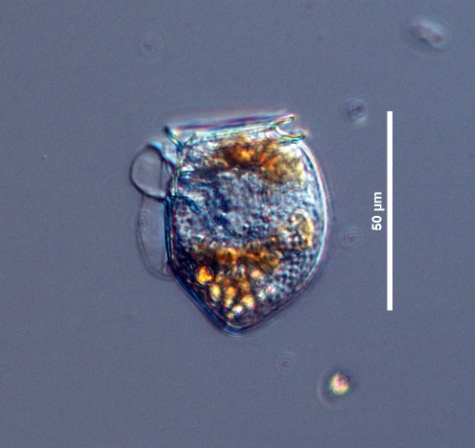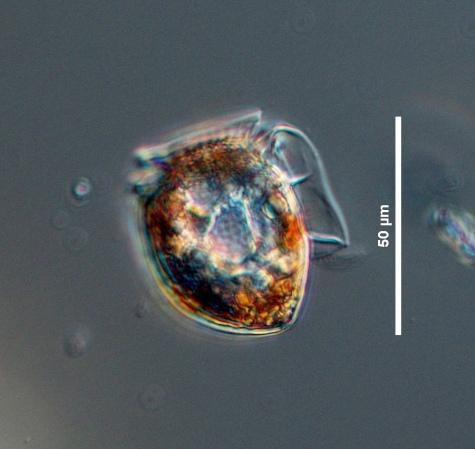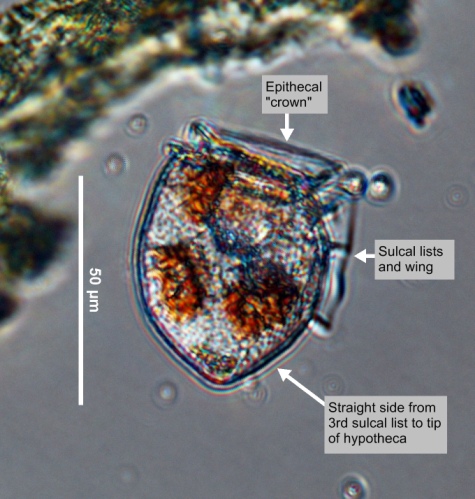



|
Synonym(s)
Classification
(Guiry and Guiry 2011)
Lifestyle
Description
Posterior
The back end of a cell. Opposite of anterior.
posterior (Dodge 1982, Horner 2002). Cells are CloseLateral
Relating to a side-to-side direction.
laterally flattened with posterior forming blunt CloseVentral
Relating to the underside of an organism; abdominal.
ventrally directed projection. Cells' broadest width is below the midpoint of the CloseHypotheca
In thecate dinoflagellates, the posterior part of a dinokont cell above the cingulum. The equivalent of a hypocone for naked dinoflagellates.
hypotheca. Cells have three well-developed CloseSulcal list (left and right)
In dinokont dinoflagellates, a well-defined groove on the ventral surface that is supported by ribs.
sulcal lists, with left CloseSulcus
"In dinokont dinoflagellates, the longitudinal area on the ventral surface that forms a furrow or depression and houses the longitudinal (trailing) flagellum" (Horner 2002).
sulcus widening towards posterior end. The first CloseRibs
Features that provide support to other structures in the cell.
rib points towards the CloseAnterior
The front. The part of the cell in the direction of movement. Opposite of posterior (HPP 2003).
anterior of the cell. The second rib is ventral. The third rib is pointing to the posterior of the cell. Two-thirds of the hypotheca (anterior side) has gentle convex sides, with straight CloseDorsal
Relating to the back portion of the cell; opposite to the ventral side.
dorsal edge in the posterior third (Dodge 1982). The side of the hypotheca from the third rib is straight while the opposite side is round forming acute angle at the junction. Chloroplasts are reddish-brown (Dodge 1982).Measurements
Diameter: 43 - 60 μm
(Kraberg et al. 2010)
Similar species
Harmful effects
Lipophilic
Having the ability to combine with or dissolve lipids.
lipophilic toxins (okadaic acid derivatives and pectenotoxins) that cause diarrhetic shellfish poisoning (DSP; Escalera et al. 2010).Habitat
Distribution
Growth conditions
Nutrients
Various chemical substances that an organism needs for metabolism (i.e., to live and grow). These are usually taken up from the environment. Some examples include nitrate, phosphate, silica (for diatoms), iron, copper, etc. Some nutrients, like copper, are required for growth, but can also be toxic at high levels.
nutrients concentrations (Miota et al. 2006). Very high abundances are found in subsurface layers of thermally and saline-stratified CloseWater column
Referring to a water system from the surface to the bottom sediments. This can be used to understand processes of stratification, mixing and their relationship to nutrient transport. Temperature, salinity, pH, and nutrient levels often vary along the length of the water column.
water columns (Miota et al. 2006).Environmental Ranges
Temperature range (°C): -1.314 - 22.429
Nitrate (μmol L-1): 0.551 - 10.777
Salinity: 18.564 - 36.252
Oxygen (mL L-1): 4.915 - 9.116
Phosphate (μmol L-1): 0.048 - 0.745
Close
Silicic acid
A general term to describe chemical compounds containing silicon, oxygen and hydrogen with a general formula of [SiOx(OH)4-2x]n. Diatoms polymerize silicic acid into biogenic silica to form their frustules (Azam and Chisholm 1976).
Silicate (μmol L-1): 0.754 - 36.110(EOL 2011)
Bloom characteristics
References
Dodge J. D. Marine Dinoflagellates of British Isles. Her Majesty's Stationary Office, London, UK. 303.
Encylopedia of Life (EOL). 2011. Dinophysis acuta Ehrenberg 1839. http://eol.org/pages/901406/details. Accessed 26 Dec 2011.
Escalera, L., Reguera, B., Miota, T., Pazos, Y. and Cerejo, M. 2010. Bloom dynamics of Dinophysis acuta in an upwelling system: in situ growth versus transport. Harmful Algae. 9(3): 312-322.
Guiry, M. D. and Guiry, G. M. 2011. Dinophysis acuta Ehrenberg 1839. http://www.algaebase.org/search/species/detail/?species_id=52218. Accessed 05 May 2011.
Horner, R. A. 2002. A Taxonomic Guide To Some Common Phytoplankton. Biopress Limited, Dorset Press, Dorchester, UK. 200.
Miota, M. T., Gonçalves, L. S., Oliveira, P. B. and Falcão, M. 2006. A bloom of Dinophysis acuta in a thin layer off north-west Portugal. African Journal of Marine Science. 28(2): 265-269.
Reguera, B., Bravo, I. and Fraga, S. 1995. Autoecology and some life history stages of Dinophysis acuta Ehrenberg. Journal of Planktonic Research. 17(5): 999-1015.
Smithsonian Institution. 2011. Dinophysis acuta Ehrenberg 1839. http://botany.si.edu/references/dinoflag/Taxa/Dacuta.htm. Accessed 23 Oct 2011.
Steidinger, K. A. and Tangen, K. 1997. Dinoflagellates. In: Tomas, C. R. (ed.) Identifying Marine Phytoplankton. Academic Press, Inc., San Diego. 429.
